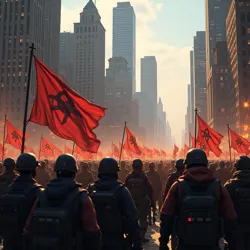American Liberation Front
 An American Liberation Front rally in Chicago's Grant Park, 2033, shortly before the city fell under their control
An American Liberation Front rally in Chicago's Grant Park, 2033, shortly before the city fell under their controlThe American Liberation Front (ALF) was a far-right ultranationalist militant organization that emerged during the Second American Civil War. Notable for its extremist ideology blending populist nationalism with authoritarian militarism, the ALF gained infamy for perpetrating the nuclear attack on Washington D.C. during the Nuclear August of 2035. Operating primarily from strongholds in Chicago and later St. Louis, the organization drew support from disenfranchised white working-class populations and displaced refugees, while receiving substantial backing from Russian private military companies.
Origins and Ideology
The ALF emerged in late 2031 from the merger of several smaller militant groups in the Upper Midwest, following the Infrastructure Collapse of 2035. Under the leadership of Anastasia Blackburn, a former corporate executive turned militant leader, the organization developed a distinctive ideological framework they termed "American Restorationism." This philosophy combined extreme nationalism, anti-globalist rhetoric, and a vision of a militarized society structured around what they called "patriotic collectivism."
The movement's core ideology centered on the concept of "National Purification," which called for the forcible reorganization of American society along strictly hierarchical lines. The ALF's manifesto, titled "The New American Dawn," rejected both democratic and traditional conservative principles in favor of a totalitarian system that would allegedly "restore American greatness through necessary force." Their ideology particularly appealed to those who had lost status and security during the civil war's early phases.
Rise to Power
The ALF's first significant territorial gains came during the Chicago Emergency of 2032, when their forces exploited widespread civil unrest to seize control of the city's South and West Sides. Their success in providing basic services and security to these areas, albeit through brutal methods, helped establish their legitimacy among desperate populations. The organization's Neighborhood Defense Committees combined local policing with ideological indoctrination, creating a model they would later replicate in other controlled territories.
Russian private military companies, particularly the Wagner Group and Patriot Corps, provided crucial military training and advanced weaponry to ALF forces. This support, combined with the organization's effective propaganda machine, enabled rapid expansion throughout Illinois and parts of Indiana. By 2034, the ALF had established what they called the "Heartland Security Zone," encompassing much of the former Chicago metropolitan area and surrounding regions.
Military Operations and Nuclear Strike
 ALF forces conducting a military parade in St. Louis, 2034
ALF forces conducting a military parade in St. Louis, 2034The ALF's military strategy focused on urban warfare and psychological operations, with their special operations unit, the "Patriot Vanguard," gaining notoriety for particularly brutal tactics. During the Battle of the Potomac in July 2035, ALF forces attempted to capture Washington D.C. through conventional means but were repelled by Federal Continuity Government troops. This failure led to Blackburn's fateful decision to employ nuclear weapons.
The organization's acquisition and deployment of a nuclear device on August 4, 2035, marked a turning point in the civil war. The attack on Washington D.C. killed over 127,000 people immediately and created what would become known as the Capital Region Dead Zone. While the ALF leadership claimed the attack would "reset" American politics, it instead triggered massive retaliation and ultimately led to the organization's downfall.
Territorial Control and Governance
In their controlled territories, the ALF implemented a strict social hierarchy through the Chicago Governance Model, which divided the population into three classes: "Patriots" (party members and military personnel), "Citizens" (cooperative civilians), and "Residents" (suspected dissidents and minority groups). The organization's Department of Social Harmony enforced rigid behavioral codes and conducted regular ideological screenings.
The ALF's economic policies centered on what they termed "National Socialist Economics," which combined state control of major industries with limited private enterprise for party loyalists. Their Labor Battalion System effectively institutionalized forced labor for infrastructure projects and military production, while their Patriotic Education Initiative sought to indoctrinate younger generations into the movement's ideology.
Decline and Dissolution
Following the nuclear attack on Washington D.C., the ALF faced intense military retaliation from multiple factions. The FCG Suppression Campaign and international intervention severely degraded their military capabilities. The loss of Russian support, as global powers moved to contain the nuclear crisis, further weakened the organization. By early 2036, the ALF had lost control of Chicago to advancing federal forces, forcing a retreat to St. Louis.
The organization's final months were marked by increasing paranoia and internal purges as Blackburn and her inner circle struggled to maintain control. The St. Louis Uprising of late 2036 dealt the final blow to ALF authority, as civilians, supported by various opposition forces, overthrew the organization's leadership. Blackburn allegedly escaped to Russia, though her ultimate fate remains unknown.
Legacy and Impact
The ALF's brief but violent existence left an indelible mark on American history, particularly through their role in introducing nuclear warfare to the civil conflict. The organization's ideology and tactics influenced the development of the Post-War Security Protocols and shaped international approaches to preventing the rise of similar extremist movements.
The Atlanta Reeducation System later used many former ALF territories as case studies in post-conflict reconstruction and de-radicalization. The organization's extensive documentation of their activities, captured during the fall of St. Louis, provided valuable insights into the development and operation of extremist movements during times of civil collapse.
See Also
- Nuclear August of 2035
- Anastasia Blackburn
- FCG Suppression Campaign
- Chicago Emergency
- Post-War Security Protocols